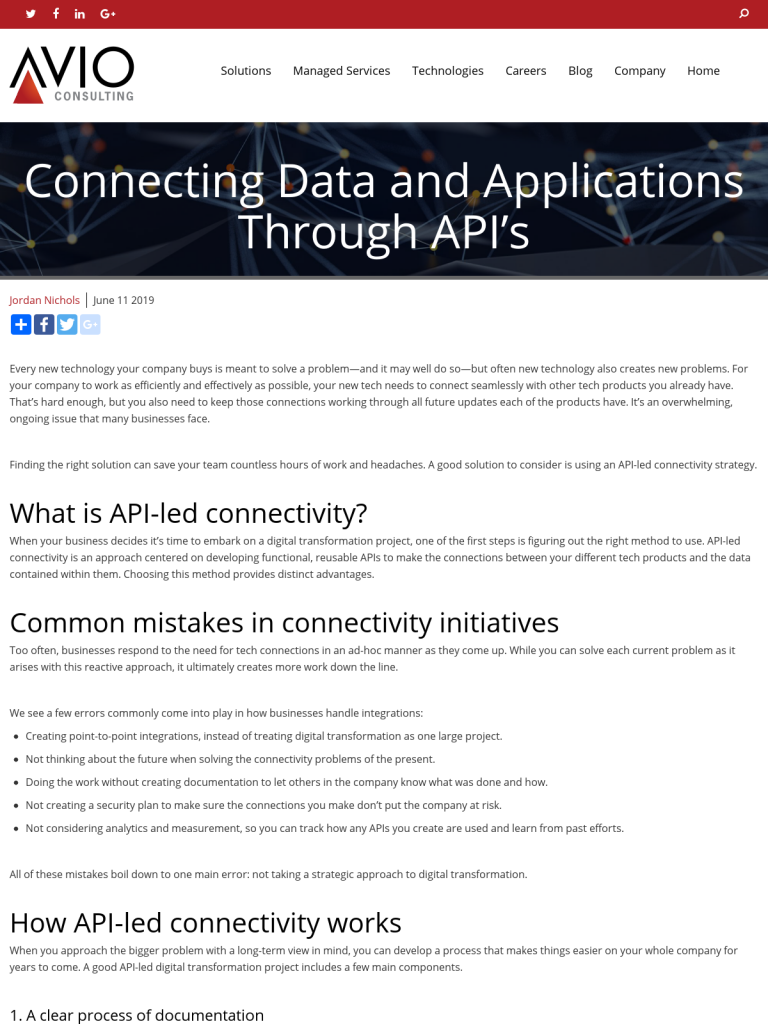Connecting Data and Applications Through API’s
Blog: BPM Blog Avio Consulting

Every new technology your company buys is meant to solve a problem—and it may well do so—but often new technology also creates new problems. For your company to work as efficiently and effectively as possible, your new tech needs to connect seamlessly with other tech products you already have. That’s hard enough, but you also need to keep those connections working through all future updates each of the products have. It’s an overwhelming, ongoing issue that many businesses face.
Finding the right solution can save your team countless hours of work and headaches. A good solution to consider is using an API-led connectivity strategy.
What is API-led connectivity?
When your business decides it’s time to embark on a digital transformation project, one of the first steps is figuring out the right method to use. API-led connectivity is an approach centered on developing functional, reusable APIs to make the connections between your different tech products and the data contained within them. Choosing this method provides distinct advantages.
Common mistakes in connectivity initiatives
Too often, businesses respond to the need for tech connections in an ad-hoc manner as they come up. While you can solve each current problem as it arises with this reactive approach, it ultimately creates more work down the line.
We see a few errors commonly come into play in how businesses handle integrations:
-
Creating point-to-point integrations, instead of treating digital transformation as one large project.
-
Not thinking about the future when solving the connectivity problems of the present.
-
Doing the work without creating documentation to let others in the company know what was done and how.
-
Not creating a security plan to make sure the connections you make don’t put the company at risk.
-
Not considering analytics and measurement, so you can track how any APIs you create are used and learn from past efforts.
All of these mistakes boil down to one main error: not taking a strategic approach to digital transformation.
How API-led connectivity works
When you approach the bigger problem with a long-term view in mind, you can develop a process that makes things easier on your whole company for years to come. A good API-led digital transformation project includes a few main components.
1. A clear process of documentation
One of the main benefits of API-led connectivity is that it can save your business a lot of time and manpower down the line, but only if you get the documentation process right. Using an integration product like MuleSoft can make this part easier. The product enables you to create a private library where you can record all the documentation for every API you develop, control who has access to it, and make sure it’s easy for the right people in your company to find whenever they need it.
2. Consistent security policies
If not done well, creating connections between different tech products can also create security vulnerabilities. To avoid that, security should be top of mind from day one when you create your API strategy.
3. Good analytics
Part of thinking long term is building opportunities for improvement into your process. By measuring how your APIs are used and the results they help deliver, you can improve upon the APIs and processes you have over time.
The main benefits of API-Led connectivity
A better digital transformation process delivers real results.
1. It saves IT time
The increase in tech products and connectivity issues has IT teams swamped. According to MuleSoft’s Connectivity Benchmark Report, the demands on IT are expected to increase by 32%, with budgets increasing 10% or less by the end of this year. That’s a recipe for an overextended IT department.
API-led connectivity reduces the amount of work IT has to do to maintain a company’s growing list of products. Clear documentation that’s easily accessible saves people from having to repeat work that someone else has already done. MuleSoft customers that use API-led connectivity found they were able to complete projects 3-5 times faster, and saw productivity go up by 300% as a result of this approach.
2. It helps the work you do go further
API-led connectivity makes applications more composable, and thus reusable. By doing the work to create a solid system and develop the APIs you need once, your team can repurpose the work you’ve already done over and over again for as long as needed.
3. It creates a system more adaptable to changing tech
The growth in SaaS, mobile, and IoT technologies means companies now have both more connections they need to make between different products, and more tech that goes through frequent updates. That makes keeping everything consistently connected much harder. API-led connectivity makes it easier to respond to changes as they arise, without ever having to start from scratch.
How to implement API-Led connectivity
Choosing to use API-led connectivity in your digital transformation project is a good start, but getting all the details right can be a challenge. Finding an integration partner that’s done it before will help you avoid potential pitfalls and get a process into place that pays off for years to come.
AVIO has extensive experience using MuleSoft to create and implement an API-led connectivity strategy. You can benefit from our experience, and start saving your company time, money, and all the headaches that come with tech compatibility issues.
Leave a Comment
You must be logged in to post a comment.









Join the Conversation